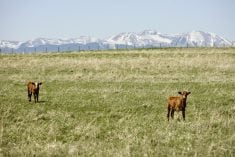In my last two columns, I have written about issues regarding starting cattle on feed and with the use of grain screening pellets in backgrounding and wintering diets. With this column, I want to focus on developing backgrounding rations for weaned calves, particularly issues with setting up diets from an energy density perspective.
Backgrounding is simply another term for growing out weaned calves. This practice allows the calf to develop frame and muscle without putting on fat. The goal is to develop calves such that they are a sufficient size to go onto finishing diets or in some cases to a target weight for grass in the spring. A well-designed backgrounding program has targeted end points, typically specific body weights and/or marketing dates. Based on these end points and the sex and weaning weight of the calf you are starting with, there are a variety of programs from which to choose. Traditionally, weaned calves weighing between 500 and 600 pounds are backgrounded over the winter to be marketed as short yearlings in late winter or early spring. Target rates of gain vary with the type of calf fed. Medium-frame calves destined for sale as short yearlings are grown out at rates of gain ranging from two to 2.25 pounds per day, while larger-framed calves are grown out at slightly faster rates (2.25 to 2.75 pounds per day). Typical target weights range from 850 to 900 pounds with days on feed ranging from 120 to 150 days or longer, depending on the program. Cattle backgrounded over the winter for turnout to grass in the spring are typically lighter at weaning (i.e. 400 to 500 pounds). The goal is to grow these calves at slower rates of gain (i.e. 1.5 to 1.75 pounds per day) such that they weigh 650 to 700 pounds when turned out to grass. Such programs are gaining in popularity with cow-calf producers who are calving later and want to add weight to their calves prior to marketing.
Read Also

Body condition, nutrition and vaccination for brood cows
One of the remarkable events of the past century related to ranching has been the genetic evolution of brood cows….
The challenge to achieving specific rates of gain when backgrounding calves regardless whether you are targeting 1.5 or 2.5 pounds per day is developing a ration that has the appropriate energy content. Assuming that all other nutrients such as protein are not limiting growth, dietary energy intake will determine the calf’s rate of gain. Calves require energy for both maintenance (i.e. net energy for maintenance; NEm) and productive (i.e. net energy for gain; NEg) purposes. Maintenance energy is used to keep the animal alive. The maintenance requirement varies with body weight, environment (i.e. wind, temperature), activity, hair coat and pen condition (i.e. wet and/or muddy). The heavier the calf, the colder the temperature, the more effort required to get to the feed bunk, the higher the maintenance energy requirement. Productive energy is the available energy in the feed that remains after the maintenance requirement has been met. It can be used for functions such as pregnancy and lactation and in the case of backgrounding calves for body weight gain. The greater the expected rate of gain, the higher the net energy for gain requirement. Typical backgrounding diets range from 0.8 to 1.1 mega calories (Mcal) of NEg per kilogram of dry matter (DM). This range is roughly equivalent to 63 to 70 per cent total digestible nutrients, for those of you more familiar with expressing energy levels in this fashion.
The first step in formulating diets to a specific energy density is knowledge of the energy content of your forages as well as any feed grains or byproducts that you intend to feed. This is best accomplished through a feed test. The next step is to determine the forage-to-concentrate ratio that supplies the desired energy level in the ration. To illustrate, consider the following example where you want to background 550-pound medium-frame calves over the winter at approximately 2.0 pounds of weight gain per day. Your target ration energy density is 1.79 and 0.99 Mcal of NEm and NEg per kilogram of DM, respectively. Your alfalfa/grass hay has NEm and NEg values of 1.17 and 0.61 Mcal per kilogram of DM, while barley grain has respective values of 2.03 and 1.37 Mcal. In order to achieve the target level of NEm and NEg in the diet for calves eating at 2.5 per cent of body weight (DM basis), a blend of 51 per cent hay and 49 per cent barley grain would be required. Again for those of you more accustomed to TDN, this mixture would provide a TDN value of 69 per cent. If you were intent on backgrounding calves for grass at approximately 1.5 pounds per day then a ration with a lower energy density would be required and the ratio of hay to barley would widen (i.e. more hay relative to grain).
Choosing the correct energy density for backgrounding calves can be difficult. Too high a level of energy and calves can gain too rapidly while too low a density will result in gains lower than expected. One tool that can greatly assist you with this task is the Alberta Agriculture COWBYTES program. I highly recommend this tool for producers who are interested in developing their own rations for overwintering cows and calves.

















